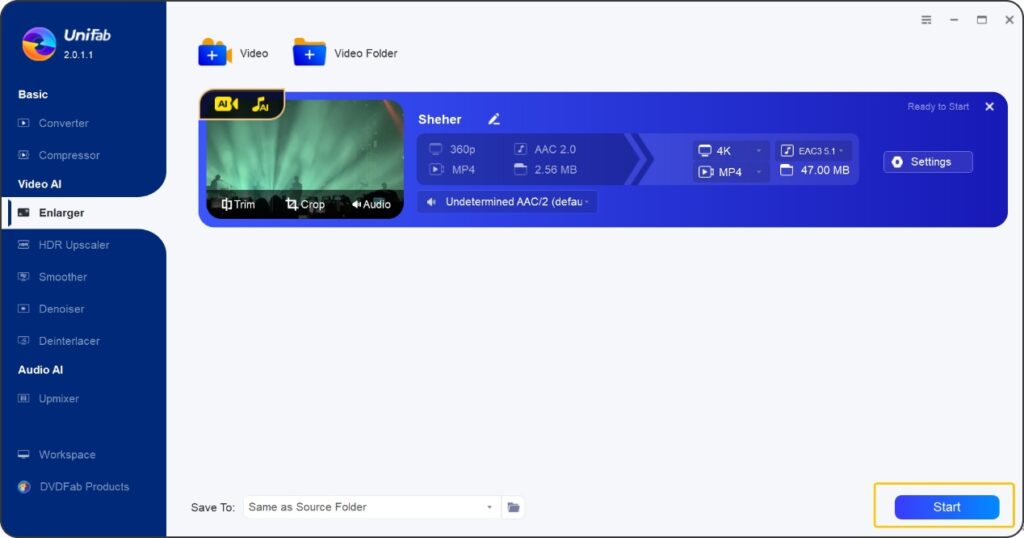In the digital era, video serves as a pivotal medium for communication, entertainment, and education. Whether you are a content creator aspiring to disseminate works of high caliber or merely a user looking to refine the quality of home videos, enhancing video fidelity remains paramount. This article delves into the methodology of video quality enhancement and enumerates the optimal software for various operating systems, highlighting their respective strengths and limitations.
For Windows: UniFab Video Enhancer
For Windows users, UniFab is a cutting-edge software solution specialized in video quality enhancement using artificial intelligence. It is designed to upscale videos, improve resolution, and bring clarity to old and low-quality footages.

Strengths:
- AI-driven upscaling: Utilizes neural networks to upscale videos from SD (480p) to HD (1080p) or 4K.
- SDR to HDR conversion: Support you to upscale SDR videos to HDR10/Dolby Vision.
- Easy to use: Provides a user-friendly interface that makes it accessible even to beginners.
- Batch processing: Allows for the enhancement of multiple videos at once, saving time and effort.
- Compatibility: Supports a wide range of video formats and works with various resolutions and frame rates.
Limitations:
- Resource intensive: May require a high-end computer to process videos efficiently.
- Limited editing features: Focuses more on video enhancement and less on general video editing tools like transitions and text.
For Windows: Adobe Premiere Pro
For Windows users, Adobe Premiere Pro stands as a paragon in the realm of video editing. It is replete with an extensive array of tools and features designed to augment video quality, including color correction, RGB curve adjustments, and the refinement of clarity and contrast.
Strengths:
- Professional-grade color correction tools: An expansive selection of color correction options.
- Rich video effects: Includes noise reduction and sharpening functions to enhance video clarity.
- Advanced audio processing: Comes with an in-built sound library and mixing consoles.
- 4K support and swift rendering capabilities: Equipped to handle high-resolution videos with alacrity.
Limitations:
- Cost intensive: Requires a regular subscription fee.
- Steep learning curve: Potentially daunting for newcomers.
For macOS: Final Cut Pro
Final Cut Pro presents a tailored solution for macOS users in elevating video quality. It has left an indelible mark on the world of video editing, offering advanced tools to enhance video sharpness and dynamic range.
Strengths:
- Specifically designed for Mac: Integrates seamlessly and delivers optimized performance.
- Intuitive user interface: Effortless to master, courtesy of its drag-and-drop functionality.
- Potent rendering prowess: Harnesses Apple hardware to accelerate workflow processes.
Limitations:
- Exclusive to Apple’s ecosystem: Inaccessible to non-Mac users.
- Significant upfront investment: Commands a relatively high one-time purchase cost.
Cross-Platform Pick: DaVinci Resolve
DaVinci Resolve is a formidable cross-platform tool compatible with Windows, macOS, and Linux systems. It emphasizes color grading and post-production, marking it as an exceptional choice for video quality enhancement, particularly in coloration.
Strengths:
- Professional color grading: Features cinema-grade color adjustment capabilities.
- Comprehensive video editing suite: Encompasses cutting, sound mixing, and visual effects, among others.
- Free foundational version: Offers a robust set of features at no cost for individual users.
Limitations:
- Complex interface: May require a period of adjustment for novices due to its intricacy.
- Resource-intensive: Demands high-caliber computer hardware.
For Mobile Devices: KineMaster
An increasing number of video production tasks are being performed on mobile devices. For those seeking to bolster video quality on smartphones or tablets, KineMaster stands as a highly popular selection.
Strengths:
- Touch-friendly operation: Boasts an intuitive interface crafted for touchscreens.
- Multilayer video editing: Supports layered editing for images, text, and audio.
- Resource-rich asset store: Includes assets such as music, fonts, and stickers.
Limitations:
- Watermarked exports: The free version embeds a watermark in videos.
- Premium features require payment: Professional edition needed to unlock additional capabilities.
Conclusion
When choosing video quality enhancement software, you should make decisions rooted in your needs, budget, and the type of device you possess. Regardless of the software you settle upon, it is advisable to invest time into mastering its specific functions and techniques to fully harness their potential in improving your video quality. Remember, the essence of your content and editing skills are always of the utmost significance. Only through high-quality raw footage combined with apt editing finesse can one produce truly captivating video creations.